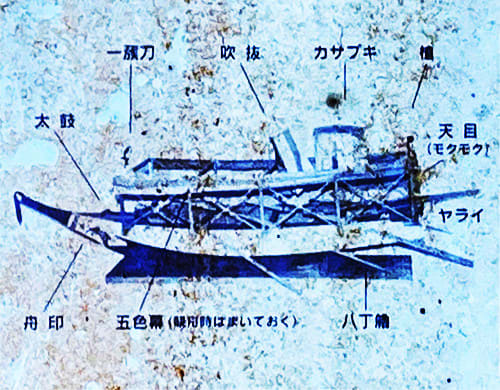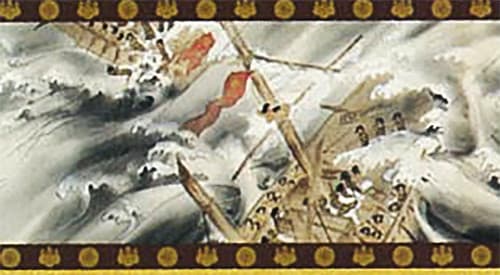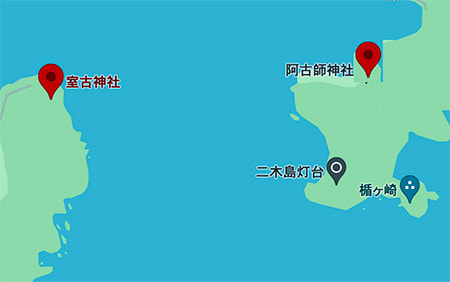



さて熊野の得意な地形については、北海道人としてある種の「既視感」を持つことについて昨日触れた。それは北海道にも複数が確認される「カルデラ」地形の残像があるのではないかと。
特徴的な「柱状節理」に関しては中学校の修学旅行で視認している。そういった地形がはるかな南国・紀州で再会するみたいな。このことについては明日以降のブログ記事で深掘りで触れたい。
そういった「特異な地形」要因を知ってか知らずにか、皇統神話には熊野上陸のシーンが大きく扱われて古事記に遺されている。瀬戸内海世界での移動、戦闘が前段として記述された後、大和地域に進出するのに「日を背に負って戦う」という大戦略に基づいて、大和地方の「東部」から「西部」に向かって進軍することになる。
そういう大方針に従って、神武東征軍は長駆して熊野からの上陸を目指すことになるわけだ。
この段階で神武帝の長兄にして実質としての主将たる五瀬命はすでに落命している。いちばん上の図は、橿原神宮の発行する「由緒略記」からのもの。そして乗船していた「関船」<貴人の船。図は阿古師神社にある想像図>は熊野灘の太平洋上で大暴風に翻弄される。こうした暴風に対して、遺された神武帝の兄2人が入水して海の神を静めたとされている。
古代の航海においてしばしばこの人身御供シーンは出てくる。
ヤマトタケルの関東進軍でもこういうシーンはあり、妃が入水したことで「あづま〜吾妻」という地域名が詠まれたとされる説話を生んでいる。科学的な分析の及ばない時代、こうした荒ぶる自然現象に対しての人間側の対応として、ある種、一般解であったものかもしれない。船の舳先に男子が縛り付けられるという人身御供の習俗が連綿とあったことが大きく連想されてくる。
神武帝の2人の兄は最終的に神武一統が上陸したと説話化された二木島の港の海上の入口の左右に祀られたとされている。<もちろん上陸地について諸説あるなかの一般的な有力説>
しかし実際にこの阿古師神社に参詣すると、皇統の由縁を持つ社格とは思えない質朴・簡素さに気付かされる。
長兄の五瀬命については皇統成立後、その陵は紀伊国の竃山に祀られたとされるのに比較して、きわめて簡素だとも思える。皇統説話がそのまま歴史なのだとするとすればこのあたりその真実性には疑念を生じさせる部分。一方で日本民俗の末子相続の風習も微妙にあるのかも知れない。
ただ、実際にこの地を歩いてその自然の奥深さに触れたわたしとしては、腑に落ちる部分もある。なんといってもこの楯ヶ崎への険しい行路では自然の象徴のように野生のシカにまで遭遇したのです。
険しい行路の山道のなか、静寂な空気感につつまれたなかで突然の出会いとしてあったのだけれど、驚きというよりもごく静謐なイキモノ同士の間の親和感に包まれていた。
もちろん内心驚きはあるのだけれど、あまりにも心理的に神々しくおだやかで、そういう空間性の中で皇統が祀られていることに不思議な納得感もあった。
熊野詣という日本的営為全体の中に、こういう空気感があったのではと思えるのですね。
English version⬇
The Sufferings of the Jimmu Expedition and Its Sublimation: The Myth of the Imperial Lineage and a Journey to Kumano - 3
On the way to the Akoji Shrine, we encountered wild deer. A divine encounter between two equestrians in a mysterious and quiet psychological state. Psychological harmony with mythology (laugh). ...
Now, I mentioned yesterday that I have a certain "sense of déjà vu" as a Hokkaido-goer with regard to Kumano's specialty topography. It is thought that there are afterimages of "caldera" landforms, several of which have been confirmed in Hokkaido.
I have seen the characteristic "columnar joints" on a junior high school excursion. It would be like seeing such landforms again in Kishu, a faraway tropical island. I would like to discuss this in depth in a blog post to come tomorrow.
Whether or not we know of such "unique geographical features," the scene of the landing at Kumano is prominently included in the Kojiki, the oldest surviving record of Japanese history, in the mythology of the imperial lineage. After the movement and battle in the Seto Inland Sea world are described as the first part of the story, they would march from the "eastern" part to the "western" part of the Yamato region based on the grand strategy of "fighting with the sun on their backs" to advance into the Yamato region.
In accordance with such a grand policy, the Jinmu East Expeditionary Force was to make a long drive to land from Kumano.
At this stage, Gose-no-Mikoto, the eldest brother of Emperor Jinmu and in effect the chief commander, had already lost his life. The top image is from the "Brief History of the History" published by the Kashihara Shrine of Kashihara. The top image is from the "Kashihara Shrine's Brief History of the Kashihara Shrine. The boat was tossed about by a great storm on the Pacific Ocean in the Kumano-nada Sea. In response to the storm, two surviving brothers of Emperor Jinmu are said to have entered the water to calm the sea gods.
This human sacrifice scene often appears in ancient voyages.
Such scenes also occurred during Yamatotakeru's march to the Kanto region, and the queen's entering the water is said to have given rise to the legend that the name of the region, "Azuma-Azuma," was composed. In an age when scientific analysis was not available, this may have been a common human response to such a violent natural phenomenon. The fact that the custom of hinokimi gyoji, in which a man is tied to the bow of a ship, has continued uninterruptedly is greatly reminiscent of this.
The two elder brothers of Emperor Jinmu are said to have been enshrined on either side of the entrance to the sea at the harbor of Futakijima, where the Jinmu line was eventually said to have landed. <This is, of course, the prevailing theory among the various theories about the landing site.
However, when one actually pays a visit to the shrine, one is struck by the simplicity of the shrine, which one would not expect to find in a shrine with an imperial lineage.
Compared to his eldest brother Gose-no-mikoto, whose mausoleum is said to have been enshrined on Mount Gamayama in Kii Province after the establishment of the imperial lineage, the shrine is extremely simple. If the imperial lineage is history as it is, this part of the story raises doubts about its veracity. On the other hand, the custom of inheritance of the youngest child in Japanese folklore may also be subtle.
However, as someone who has actually walked through the area and experienced the depths of its natural environment, some aspects of the story make sense to me. After all, on this steep path to Tategasaki, I even encountered wild deer as a symbol of nature.
It was a sudden encounter on a steep mountain road, in the midst of a quiet atmosphere, but rather than surprise, I was enveloped in a very tranquil sense of affinity between two creatures.
Of course, I was inwardly surprised, but I also felt a strange sense of satisfaction at the fact that the imperial lineage was being enshrined in such a space, which was psychologically so divine and serene.
It seems to me that this kind of atmosphere existed in the whole Japanese activity of Kumano pilgrimage.



















